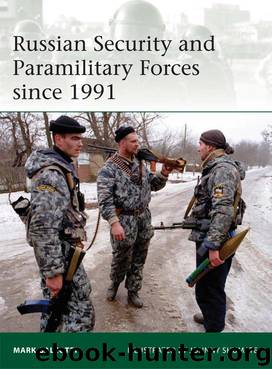Russian Security and Paramilitary Forces since 1991 by Mark Galeotti

Author:Mark Galeotti
Language: eng
Format: epub
Tags: Russian Security and Paramilitary Forces since 1991
ISBN: 9781780961071
Publisher: Osprey Publishing
An operator from the Interior Troops’ 604th Special Purpose Center, one of the most elite of the spetsgruppy. Black tactical uniforms and masked balaclavas have become commonplace among such units, leading some other police officers to describe them collectively as “black masks.” Although the FSB’s Alpha remains Russia’s most celebrated antiterrorist outfit, the gap in training, capability, and kit between it and units such as the 604th TsSN is narrowing. (Vitaly Kuzmin)
ALPHA
Russia’s senior antiterrorism commando unit, which has been deployed at all key events of recent years, is the FSB’s Alpha (Al’fa) group. Although other units tend to question whether it is any more skilled and professional than they are, it is undoubtedly the most famous of Russia’s security forces, and enjoys a reputation for ruthless proficiency.
It was formed within the KGB’s Seventh (Surveillance) Directorate in 1974, and, like the Dzerzhinsky Division’s RSN, this was initially a response to the approach of the 1980 Moscow Olympics. Following the Munich massacre at the 1972 Olympics in Germany, when Palestinians killed 11 Israeli athletes and officials and a West German police officer, KGB chairman Yuri Andropov wanted to ensure that the USSR had a counterterrorist force comparable to West Germany’s GSG-9 and Britain’s SAS. Originally numbering 30 men under Col Vitaly Bubenin, it attracted military Spetsnaz, athletes, and even one USSR boxing champion, Gleb Tolstikov. It grew steadily to just under 100 men by 1979, with smaller detachments based in Alma-Ata, Khabarovsk, Kiev, Krasnodar, Minsk, and Sverdlovsk (the city later renamed Yekaterinburg), to ensure a rapid response to any incidents. Alpha saw its first taste of action in an unexpected and offensive role, however.
As the Soviets prepared their invasion of Afghanistan in 1979 – hoping to pacify the country quickly with a show of force, and to replace the radical Communist leader Hafizullah Amin with the more tractable Babrak Karmal – two detachments each of 24 Alpha operators, codenamed Grom (“Thunder”) and Zenit (“Zenith”), were secretly infiltrated to Kabul. They were led by Viktor Karpukhin, who would later command Alpha and who remains a legendary figure amongst the Spetsnaz. On December 27, 1979, along with military Spetsnaz and paratroopers, they launched Operation Storm-333, seizing the presidential Tajbeg Palace and killing Amin. Alpha lost only two soldiers in the attack despite the heavy defenses around the palace. Thereafter Alpha would play a sporadic role in the ensuing Afghan War (1979–89), but its primary role remained domestic.3
The Moscow Olympics passed without incident (beyond the Western boycott in protest at the Soviet invasion of Afghanistan), but in the years to come Alpha would be called upon to respond to a range of difficult challenges. For example, in Sarapul in 1981 two draftees took 25 children hostage at a local school and demanded to be flown to the West. Both were seized after a period of negotiation, with all the hostages released unharmed. More bloody was the hijacking of an Aeroflot passenger jet on a domestic flight in 1983. The hijackers, seven young Georgians, were demanding to be allowed to fly to Turkey.
Download
This site does not store any files on its server. We only index and link to content provided by other sites. Please contact the content providers to delete copyright contents if any and email us, we'll remove relevant links or contents immediately.
| Africa | Americas |
| Arctic & Antarctica | Asia |
| Australia & Oceania | Europe |
| Middle East | Russia |
| United States | World |
| Ancient Civilizations | Military |
| Historical Study & Educational Resources |
Red Famine: Stalin's War on Ukraine by Anne Applebaum(2816)
Chernobyl by Serhii Plokhy(2438)
Midnight in Chernobyl by Adam Higginbotham(2391)
The House of Government by Slezkine Yuri(2105)
Midnight in Chernobyl: The Untold Story of the World's Greatest Nuclear Disaster by Adam Higginbotham(2079)
Red Shambhala by Andrei Znamenski(2072)
The Gulag Archipelago (Vintage Classics) by Aleksandr Solzhenitsyn(1985)
All the Kremlin's Men by Mikhail Zygar(1962)
From Cold War to Hot Peace by Michael McFaul(1940)
Red Notice by Bill Browder(1929)
Putin's Labyrinth(1902)
The Future Is History by Masha Gessen(1822)
From Russia with Lunch by David Smiedt(1797)
A People's Tragedy by Orlando Figes(1768)
The Romanovs by Simon Sebag Montefiore(1723)
How to Tame a Fox (and Build a Dog): Visionary Scientists and a Siberian Tale of Jump-Started Evolution by Lee Alan Dugatkin & Lyudmila Trut(1680)
Putin's Labyrinth: Spies, Murder, and the Dark Heart of the New Russia(1664)
The Lost Spy by Andrew Meier(1634)
Art and Revolution by John Berger(1607)
